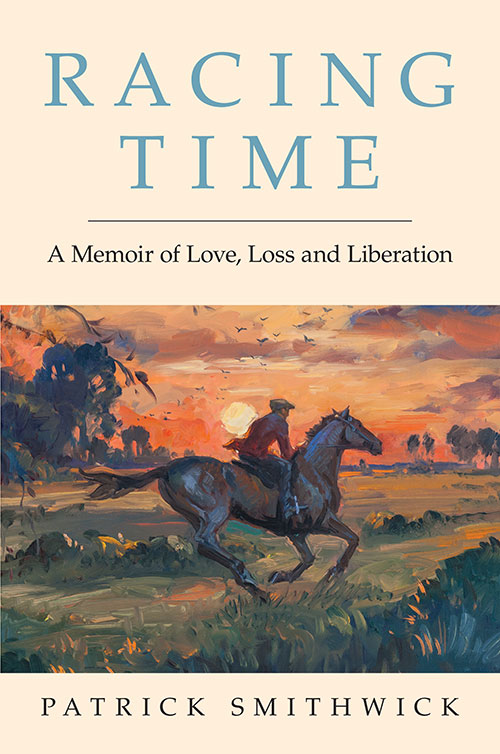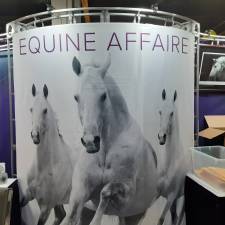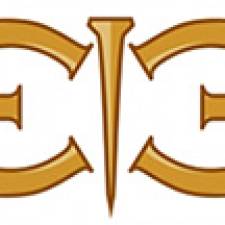
by Patrick Smithwick
Chapter 2 "In Its Own Orbit"
It’s late-June. It’s early-July. It’s late-July. The race is coming up. The A. P. Smithwick Memorial. Every year the date nears, the pressure increases, the excitement builds, post time is in minutes, gamblers rush to the windows, the tape is dropped and the horses are off and running. August—Thoroughbred racing at Saratoga Springs, New York. The best racing in the world. Each decade ushers in a fresh generation of riders. A few veteran trainers fade away; their sons pick up the trade. New, fresh horses run. New owners with new money stand in the paddock. And the A. P. Smithwick—a bulkhead against the roiling whitewater of time, a celebration of my father “Paddy,” Racing Hall of Fame steeplechase legend—remains the same: 2 1/16 miles over hurdles, fast.
Time flows differently at Saratoga. It passes in an unreal, dreamlike state—the town, the lakes, the majestic trees; the horses, Oklahoma training track, the barns, the beauty of the main track and the irreplaceable century-old clubhouse; the betting, the Bentleys, the wads of twenty and hundred dollar bills; the bars, the restaurants, the late nights dancing; the early morning screwdrivers and fresh melons; the early evening scotch, roast beef, perfectly ripened tomatoes and just-picked corn on the cob all remaining consistent, unchanging, pooled in a deep reservoir, while friends, relatives and I launch ourselves, incrementally changed each year, into the current: we marry, have children, introduce them to the Spa, develop careers, leave racing, return to racing, lose the youthful money-making ability to pick winners through hunches, lose the endurance to get by on a few hours sleep per night, gain the wisdom to savor every moment.
When I reflect on past experiences—whether riding my bike around town as an adolescent or riding races as a youth, whether arising at 5:15 and going to the barn with my father or thirty years later arising at 5:15 and going to the barn with my best friend, Hall of Fame trainer Tom Voss—they are recorded in a different manner from my outside-of-Saratoga memories. Most of the time in my life has seemed to have existed as if time were a steadily flowing river and I am with it, the river and I are one; we don’t change much day-to-day or year-to-year, and yet, as we surge and flood, slow and swirl, we see that life and people and places on shore are changing and before we know it, a birthday is coming up, a class reunion is planned, an anniversary is approaching, and it’s a big one—a decade has gone by. Two decades have gone by. In September of 2016, four decades will have gone by, and it will be Ansley’s and my fortieth anniversary.
But when I look back at Saratoga, I see the year as an oval, like a racetrack, much like the mile and an eighth main track at Saratoga. The oval is stretched out, with winter at the top—white and gray; summer on the bottom—faded green, yellow; spring on the left—a lush green; fall on the right—rust. August is an exception; it is red and it is shimmering, flickering. Down on the bottom, right before the track heads up into fall, it intensifies for four weeks: brighter, even more heat, faster paced, much faster, a daily lifestyle like no other, little sleep, much gaiety, go-go-go, action, meeting new people, seeing old friends, making incredible connections, spending money, dishing out twenty dollar bills like they’re ones, and racing—horses, fast horses, the fastest in the world, running day after day as Rolls Royces roll by, actors and millionaire investment bankers step up to the $100 betting window, jockeys head to the jocks’ room and the “hot box” to sweat off another three pounds, trainers stand outside their barns talking to owners.
One trainer speaks intently to four septuagenarian Louisville boys, fraternity brothers, who’ve just bought a yearling at the Fasig Tipton sales the night after my father’s race for half a million, then turns and speaks just as intensely to one of the last of the old-time grooms, also a septuagenarian, a slim, fit black man from Camden, South Carolina, who knows more about how to take care of a horse than anyone in the barn—his father rubbed horses, his grandfather rubbed horses—and who doesn’t have enough in the bank to retire and who doesn’t give a damn, he doesn’t want to retire, he doesn’t have much time left, he’s racing time, and this new half-million-dollar colt in the stall behind him is going to be his big horse next year; this new horse will be taking him to Churchill Downs the first weekend in May.
Saratoga is brighter, hotter—the parts are moving; it’s like a Mondrian, like Broadway Boogie Woogie, but not still, not stationery; the shapes are moving, they’re hopping, they’re popping, they’re dancing, to jazz, to my father’s favorite, Louis Armstrong singing Mack the Knife.
The August memories are not part of the gallop around the annual track of time. They are separate. They are sections of the oval, which are taken out, and which exist one on top of the other; they are mini-ovals that exist in the full annual oval of life, and, they are not arranged chronologically. They are pancakes which can be shuffled like a deck of cards in my mind. Records—that’s better. Vinyl albums. Each visit to Saratoga is imprinted on a beautiful, black, slick, light-weight, full-frequency 33 1/3 speed LP equipped with stereophonic sound as well as the added feature of full color cinematography. They are on the shelf of my mind, and they are not neatly stacked; they’re spread out, and they’re out of order. If I want to recall one summer’s visit to Saratoga, I put four or five of them from that period on the turnstile, all at once, and start playing them.
There are the great memories: winning a steeplechase race over hurdles on Tote’m Home II at Saratoga, Pop the trainer, Emmett Grayson and Jack the Indian the grooms, when I was eighteen. Two years later, winning again, this time on Wild Amber, Pop the trainer. I can recall in my body how we started to make our move coming around the turn and heading down the stretch into the last fence, how each horse jumped the last fence—this back when there was a last fence on the stretch—how we passed the lead horses, and exactly what it felt like going under the wire, in front, pulling up, easing up, standing up in the irons, galloping out, jogging through the gap, out onto the flat track, and then cantering back to Pop waiting for me by the winner’s circle.
Then my mind will slip to an album I’d rather forget: the time I rode eighteen-hands plus Limbo at Saratoga in a maiden steeplechase over hurdles, the tree of the saddle broke, the saddle slid up on his neck, and I got run off with, opened up twelve lengths on the field, my feet banging together under his neck.
At Saratoga, when I see the twelve-horse barn just across from the track kitchen in Horse Haven my mind leaps to Pop and Tom and Emmett and Jack the Indian and Mike the Englishman. It seems a lifetime ago, like someone else’s life. I can feel it, feel the textured wool of the blue and white checkered blankets we threw over the horses on the chilly mornings after they’d galloped and been washed in steaming soapy water; I smell it, inhale the dashes of pine oil Emmett poured in the wash water; smell the clean, wet clover after the hay man dropped it off; smell the soaped leather of the saddles and bridles in the tack room mingling with the smoke of Pop’s Pall Mall; feel the smooth curvature of the indentation in the dirt one step from the tack room and the worn spot in the old floor board, the first step into the tack room. I feel the tension of Pop giving me a leg up on Wild Amber knowing we were going out for a school on National Steeplechase and Hunt Day with hundreds of spectators and an announcer there, and the race coming up, and knowing my great friend Mike White just ten barns down, was getting a leg up from his father, and soon we’d be going a turn-of-the-field head-and-head. I feel the pain and strain in my arms and fear in my body earlier that morning on my first horse, leaning back, pulling as hard as I can, my irons jacked up higher than usual, the reins covered in sweat and sliding through my fingers, having to reach back, pull my bandana out of my back pocket, slap it across one rein, our pace quickening, quickening, trainers and grooms leaning on the outside rail of Oklahoma watching as the unreal-sized Limbo threw his head, trying to wrench the reins out of my hands, took his gigantic strides, and they all wondered if he would take off, run off, crash through the outside rail with me at any minute. I remember the early 6:00 a.m. calm, the faint mist coming up off the wet grass, Emmett and Jack quietly finishing mucking out their stalls. I taste the steaming hot, raunchy, racetrack kitchen coffee—black—feel it in my mouth and going down into my empty, shrunken stomach as I set out the tack, preparing to get on the first horse of the morning, Pop in the chair outside the tack room, cigarette in mouth, legal pad in lap, writing down the sets. I smell the sweetness of his cup of coffee, made with sugar and cream, mix with the scent of burning tobacco leaves, as, carrying my tack, I walk past him.
When I was twelve, thirteen and fourteen I worked for Pop and my Uncle Mikey, both to become Hall of Famers, at the Annex, the outcropping of two long barns off Fifth Avenue just across from Oklahoma training track. In those days, there was a jumping race every afternoon, and it was the third race, after the daily double, so post time was 2:30. In my memory is a strong, clear recording—of polishing my shoes, pulling on coat and tie and going to the races with Mom after working all morning at the Annex walking hots, riding the pony, cleaning tack, raking the walking ring. There’s the irreplaceable record—that spins forever in my mind—of standing under the trees in the old spacious paddock just a few feet away from the circling, jigging horses, watching Pop in the Old Rose silks—pink—with the yellow collar and cuff—of Mrs. Ogden Phipps, or the dark blue silks with cerise cross sashes of Mrs. Theodore Randolph, or the black and green striped silks of June McKnight—listening to Mikey, Mikey giving him a leg up, and then Pop and the horse, and the other horses and riders—Tommy Walsh, Scotty Schulhoffer, Evan Jackson, Jimmy Murphy, each a close friend of my father’s and like an uncle to me—filing out under the clubhouse and onto the track as the bugler plays the Call to the Post and then Fred Capossella in his inimitable way calls out, “The horses … are on … the track,” and ten minutes later, “The fans are moving down to the rail. That can mean o. nly one thing: It is now post time.” Pop would win or finish in the money.
With Pop’s race: we never leave Saratoga. We always go back. It is always there. The winner’s circle beckons. The year cycles back around to it. Saratoga is unreal. It is an unreal step out of time, more unreal and celebratory back when it was a four-week sprint, versus the six-week marathon of today. I have this stack of Saratoga albums in my brain, and the passage of time does not diminish or change the importance of any one record. One record on top of another. Memories are pulled out of albums from thirty years ago, from forty years ago, from yesterday. They are vivid. They are alive. They exist out there, spinning and wheeling, on their own, disconnected from the regular flow of time, separated and unattached, in their own orbit.

About the Author Patrick Smithwick is the author of the acclaimed trilogy of memoirs Racing My Father, Flying Change (winner of the prestigious $10,000 Dr. Tony Ryan Literary Prize), and Racing Time. Patrick has won awards for the writing of newspaper features, short stories and magazine pieces while working as a steeplechase jockey, Chesapeake Bay waterman, newspaper reporter, and teacher of English and medieval history at schools and colleges. He holds a B.A. and M.L.A. from Johns Hopkins University, an M.A. from Hollins College, and lives with his wife Ansley on the farm where he was raised in Monkton, Maryland.
About The Bookstore for Horse Lovers The Bookstore for Horse Lovers is a virtual bookstore is a unique platform dedicated to highlighting authors of horse books and connecting with readers in their niche. Readers may search featured authors, fiction authors, and non-fiction authors, read their official biographies, follow them on social media and click through to the designated purchase site provided by the author. Visit booksforhorselovers.com to learn more.
You can find "Racing Time, A Memoir of Love, Loss and Liberation" and more in our section on Books.












